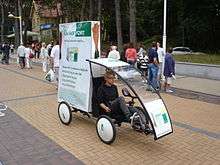Billboard bicycle

A billboard bicycle (advertising bike) is a type of mobile advertising in which a bike tows a billboard with an advertising message. Billboard bicycles, like some other forms of mobile advertising, offer a cost efficient, targeted, and environmentally friendly form of advertising. Gary Saunders of Queens, NY, New York, was credited in a 1999 New York Times article as the "brainchild" behind the billboard bicycle concept. Mr. Saunders' billboard bicycle, the Vital Sign, was geared toward messenger bikes and measured 12" by 18".[1] Since the introduction of the Vital Sign several different variations of the billboard bicycle, differing in both size and appearance, have been constructed.
Advantages

- Low cost per thousand impressions
- Environmentally friendly advertising
- Innovative and eye-catching
- Delivering high-impact impressions
- Closer to the point of sale
- High impact audio and visual combination
- Ideal for pedestrian areas
- All weather and season operation
- Can be Bluetooth and GPS tracking system enabled
- Riders can handout promotional material or do sampling
- National, regional or local campaigns
Advertising efficiency
According to research conducted by the Outdoor Advertising Association of America, when compared to other advertising forms such as radio, television, and newspaper, billboard advertising is a more effective form in terms of cost per thousand impressions (CPM).[2] National Public Radio (NPR) in a 2005 news article commented on the billboard bicycles ability to target specific audiences.[3]
Environmental impact
Billboard bicycles are human powered, thus they leave no carbon footprint; however, they may contribute to urban traffic congestion and visual pollution.
Types
Today billboard bicycles come in a variety of shapes and sizes. Some billboard bicycles are one unit. Others are composed of a bike and a detachable billboard. Some billboard bicycles are specially manufactured to have a unique look in order to further attract an audiences attention. Others are simple frames which focus attention solely on the advertising message. Some billboard bicycles use large billboards; however the size of the billboard is limited by wind constraints. Other billboards are small, like Gary Saunders messenger sign noted above.
See also
References
- ↑ Bernard Stamler, Neighborhood Report: Manhattan Up Close The New York Times, 10/19/1997
- ↑ Outdoor Advertising Association of America
- ↑ Tara Boyle, Mobile Billboards Herald Age of Drive-By Ads, National Public Radio, 4/30/2005